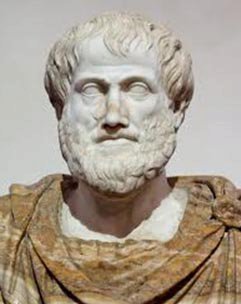Aristotle Creates the "Celestial Spheres"
Aristotle's model of the solar system came to dominate human understanding of the night sky for a thousand years. Even though many improvements on his concepts were proposed, accepted and used by astronomers over that period, and even though his writings were lost to the heirs of the Western Roman Empire when Rome fell, his conception of the sky as objects embedded in a system of interconnected spheres never lost its grip on the “mind share” of astronomers.
 Aristotle took up the challenge of his teacher, Plato, to extend Plato’s mathematical explanation of the
motion of the stars to cover the Sun, Moon and planets (especially the planets) which did not seem to move
in “regular” ways. Aristotle proposed that the planets are embedded in spheres made of a pure substance
not found on Earth, which in turn where connected to other spheres that were centered on the Earth.
Aristotle took up the challenge of his teacher, Plato, to extend Plato’s mathematical explanation of the
motion of the stars to cover the Sun, Moon and planets (especially the planets) which did not seem to move
in “regular” ways. Aristotle proposed that the planets are embedded in spheres made of a pure substance
not found on Earth, which in turn where connected to other spheres that were centered on the Earth.
This conceptual model proved to have remarkable staying power even though it did not stand up well to more detailed observations as they became available. So modifications of the model over the next 1000 years tended to be adjustments rather than entirely new concepts. In most, the Earth was moved at least slightly off-center. In some, the order of the planets (by distance of their sphere’s from Earth) would change. But almost all retained the concept of an interconnected system of perfect spheres. Once it became established in the “scientific mind”, Aristotle’s conception of the Universe took on the mantle of “common sense”. Even when other models were proposed that did a far better job of describing the Universe, their proponents often presented them as methods of calculation only – their common sense telling them that the true nature of the Universe must be more or less as Aristotle had described it.